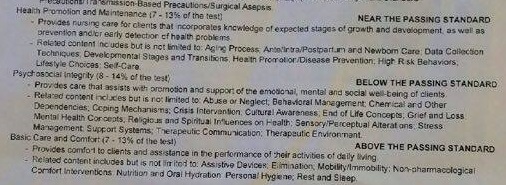You figured it out, probably shortly after you took the NCLEX – you failed it. You found out for sure when you were contacted by the board. Now what?
No matter what anyone tells you, or you hear, it isn’t the end of the world. The goal for you should be to pass it, our next series of articles will focus on that. What can you do to make sure that you pass the test the next time?
Today we’re going to talk some about what your test results can show you. We want to do the following: figure out what went wrong, make a plan for correcting it, studying / getting ready and then taking the test again.
Figuring out what went wrong.
A lot of things could have gone wrong when you took the NCLEX. The key is to be honest with yourself. The more honest you can be the better you’ll be able to evaluate why you failed (and you’ll be able to correct it for next time). If you aren’t honest with yourself then this process will be harder.
Number of questions answered.
How many questions did you answer when you took your test. If you answered 75 questions and failed the test, you have more work to do than if you had 150 questions and failed, or ran out of time and failed.
You either pass (or fail) when the test thinks you have either answered enough corrections correctly or incorrectly. If you did really well on the test, then at 75 questions the test stops.
Each question you answer determines the next question you get (either easier or harder). So how do they figure out if it is easy or hard. Each test that is taken there are a certain number of ‘test’ questions. These questions although they don’t count toward your NCLEX, they do help the NCLEX people figure out how ‘hard’ or ‘easy’ the questions are.
The letter you get back.
The letter up get back will explain some things to you too.
On the list you will have items that are Near, Below or are above the passing standard. You will want to create a word document or a spread sheet and write these down.
We’ll use the first result as an example.
Health Promotion and Maintenance (7-12% of the test) – if you remember we showed you an image of what will be on test.
Near the Passing standard – just what it means. You were close to passing that part of the test. Remember you have a line – above the line is questions you get right, below question you miss. No one really knows the exact number of correct questions above that line is passing. For this example, we’ll use 15. So you were above the line but not to the standard of 15 correct questions for that part of the test.
The next lines are an explanation and then you have related content.
Noting what you did well on means you can spend less time on studying those types of questions and more on what you did poorly on.
Why you think you failed the test.
Probably the most important part of this – why do you think you didn’t pass. This could be for a number of different reasons. Spend fifteen or thirty minutes thinking about it.
Some examples: Didn’t feel well, room was too hot or cold, distracted, didn’t know the content, test anxiety, couldn’t concentrate, etc. This is the section where it is important to be honest.
Next time we’ll talk about what you’ll do with this information.


No Responses